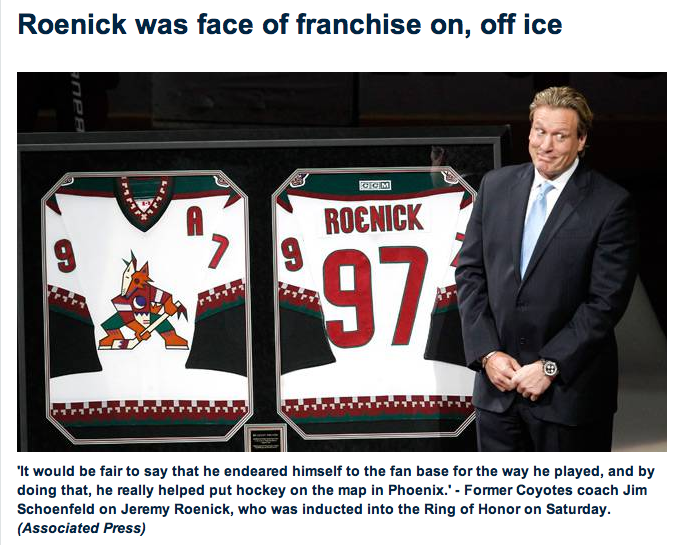Jeremy Roenick joins Coyotes' Ring of Honor
 By Jerry Brown
By Jerry Brown
GLENDALE, Ariz. – Before a standing-room only crowd packed with Phoenix Coyotes and Chicago Blackhawks fans, Jeremy Roenick entered the Coyotes Ring of Honor on Saturday – but not before coming up with one more stunning effort on the ice.
He held his acceptance speech to less than the allotted four minutes.
Roenick joined former Coyotes teammates Keith Tkachuk and Teppo Numminen on the ring high above Jobing.com Arena and was presented with an array of gifts – including the special mask attachment he wore to protect his broken jaw in Game 7 of the postseason series against the St. Louis Blues.
Roenick thanked "everyone in the state of Arizona for making us proud to be Phoenix Coyote," and reminded the current players to "wear that crest with pride."
He talked about the electric atmosphere of White Out playoff games at then-America West Arena in downtown Phoenix and how much he reveled in the chance to play for the Coyotes followers.
"Arizona has plenty of great hockey fans and you going to keep the team here. It shouldn't go anywhere. We'll show them," he said.
Videos featuring testimonials from former teammates Greg Adams, Dallas Drake, Craig Janney, as well as Numminen and Tkachuk, were shown before Roenick's name was placed next to his good friend and running mate Tkachuk on the ring.
"I'll be next to that guy forever now. Thanks a lot," he quipped.
Roenick's No. 97 joins Numminen (27), Tkachuk (7), former Coyotes coach and owner Wayne Gretzky(99), and former Winnipeg Jets players Bobby Hull (9), Thomas Steen (25), and Dale Hawerchuk (10) in the Ring of Honor.
[NHL.com]
By Craig Morgan
Coyotes owner Richard Burke, executive vice president of hockey operations Bobby Smith, general manager John Paddock and assistant general manager Taylor Burke had just arrived with the transplanted Winnipeg Jets in Phoenix in the summer of 1996.
They liked the young talent on their roster and liked the opportune timing of their arrival.
The Suns were three days away from trading Charles Barkley to Houston, ending a memorable yet unfulfilled era for the franchise. The Diamondbacks wouldn't begin play for two more seasons, nobody knew what was in store for the 1996 Arizona State football team and brash-talking coach Buddy Ryan had just been fired because the Cardinals were still the same ol' Cardinals.
But the Coyotes' brain trust knew it needed something more to sell hockey in a nontraditional market.
"We didn't have a face," Taylor Burke said, "an elite, exciting player that the community could rally around."
Jeremy Roenick was that guy. He had posted three straight 100-plus-point seasons in Chicago before suffering a horrific left knee injury in the strike-shortened 1994-95 season on a knee-on-knee hit with towering Stars captain Derian Hatcher.
Roenick's agent, Neil Abbott, had made it clear Roenick was available via trade after a few contentious years of contract squabbles with notoriously miserly Blackhawks owner William Wirtz.
So the Coyotes pulled the trigger on a deal that sent center Alexei Zhamnov, forward Craig Mills and a first-round pick to Chicago. Once he touched down in Phoenix, Roenick's myriad off-ice talents were also apparent.
"He was a PR dream," Coyotes longtime senior director of communications Rich Nairn said. "Any TV, radio or print request we got, he would accommodate it. Anything outside the game or the media we asked him to do, he did it. He just got it. He understood the importance of marketing hockey in this new market, and he was one of the few players who had the personality to pull it off."
Contrary to popular opinion, Roenick wasn't born that way.
"My wife always asks me, 'What happened to the shy, nerdy guy I met in high school?'” Roenick said, laughing.
Roenick credits a chance encounter with hockey legend Gordie Howe for planting the seeds for who he became. Howe was playing for the old Hartford Whalers in the 1979-80 season at the Hartford Civic Center when he came over to the glass where Roenick was seated and dumped snow over the top of the glass onto Roenick's head. Howe continued to skate but looked back at Roenick again and winked.
"I totally remember the way I felt when I was given some time -- the attention of a superstar -- and I took that with me my whole life," Roenick said. "I knew that if I ever got to that level, that would be a gift that could imprint on people's lives."
Roenick imprinted thousands of Valley lives. He never refused an autograph, he handed out more than his share of pucks, stick and jerseys, he talked endlessly with perfect strangers, and when the Coyotes scheduled visits to a nearby children's hospital, Roenick was the last guy to leave, making sure he'd given every kid some of his time.
"None of that stuff was ever on camera. Nobody ever wrote about that," Nairn said. "He just wanted to brighten those kids' days."
That very public side of Roenick's personality had a downside. His teammates sometimes called him "Styles" or "Hollywood," and the media often referred to him as "P.R." instead of "J.R." -- all derisive nicknames for his love of the limelight.
"Maybe I was an attention whore. It's not that I wanted it all the time, but I accepted the responsibility all the time when other guys didn't want it," Roenick said. “There's nothing wrong with being flamboyant, but if you can't go on the ice and back it up then you look pretty ridiculous. I always felt I could flash it off the ice but then bring it on the ice."
Roenick never came close to matching those magical seasons he posted in Chicago with a perennial Stanley Cup contender. Part of the reason was that knee injury, which robbed him of just a fraction of his speed and recklessness. Part of it was a host of rule changes that made 100-point seasons a rarity in the NHL. Part of it was the overall talent on the Coyotes' roster, which couldn't match what Roenick enjoyed in Chicago.
But Jim Schoenfeld, Roenick's coach for two seasons in Phoenix, remembers a player whose style belied his talent level.
"Sometimes skill players aren't as willing to play the other rough and tumble parts of the game, but he was that type of player," Schoenfeld said. "He didn't shortcut the process."
Schoenfeld knew right away which role he wanted Roenick to fill.
"For a while in the NHL, the idea was to match your best defensive line against the other team's best offensive line, but we wanted Jeremy to go against the other team's top line because he was a great two-way player. We wanted him to outperform and outscore the other team's top talent,” Schoenfeld said. "We didn't win a championship that way, but there were a whole lot of other reasons for that."
One of those was a fractured jaw Roenick suffered on a hit by Derian Hatcher in the 1998-99 season as retaliation for a hit Roenick leveled on the Stars' Mike Modano that knocked Modano out of the game.
"I wouldn't say it was flapping in the breeze, but you could see it was shattered and badly out of place,” Schoenfeld said of Roenick's jaw. "It looked pretty ugly."
It was broken in four places. Roenick played a few more shifts, including a power play, but he was out of the lineup after that.
"It wasn't fractured -- it was broken completely through," he said.
Schoenfeld initially told media members Roenick was out for the season, but that was a ploy intended to throw off the opposition. He had an inkling Roenick would try to return. He did, in Game 7 of the team's first-round playoff series with St. Louis.
The jaw was wired shut, and so was his mouth, meaning he had to breathe solely through his nose, which required frequent blowing to clear any obstructions. Roenick understood the risks, but he was more concerned with the potential reward.
"Who cares if your jaw gets broken again? It will heal. You don't have too many opportunities to win the Stanley Cup," he said. "I didn't have to use my mouth or jaw to play hockey. I used my hands, my feet and my heart."
The Coyotes didn't win that game, falling 1-0 in overtime, but Roenick won the hearts of Coyotes fans forever. Almost 12 years after he left via free agency, he remains one of the Valley's most popular athletes -- even as a hockey player -- and still keeps his only house here in the Valley.
"That's our home, and I'm very passionate about that city and that community," he said. "Besides, I always loved playing hockey one night and playing golf the next day. That was my perfect scenario."
Roenick will become the seventh player to be inducted into the Coyotes Ring of Honor on Saturday when Phoenix hosts Chicago. He joins Wayne Gretzky, Bobby Hull, Thomas Steen, Dale Hawerchuk, Teppo Numminen and Keith Tkachuk.
He is one of four American-born players to score 500 or more goals. In 20 NHL seasons, he posted 513 goals, 1,216 points and 1,463 penalty minutes. In 454 games in Phoenix, he had 152 goals, 379 points, 596 penalty minutes and scores of memorable moments.
"I always say that hockey is a hard way to make an easy living," Schoenfeld said. "You have to have a high level of resolve, courage and physical sacrifice, but once in a while, a player takes all of that to another level, and Jeremy did that.
"It would be fair to say that he endeared himself to the fan base for the way he played, and by doing that, he really helped put hockey on the map in Phoenix."



